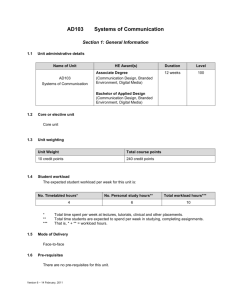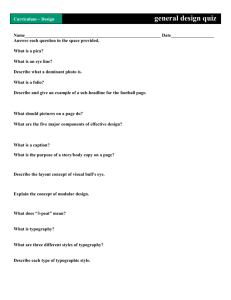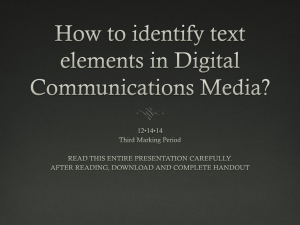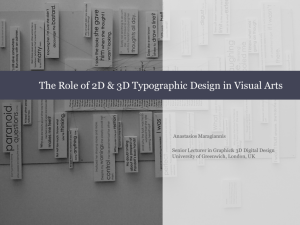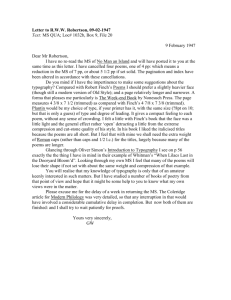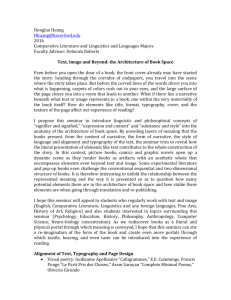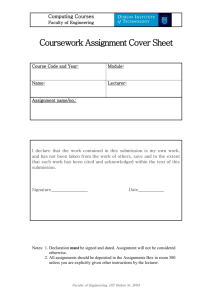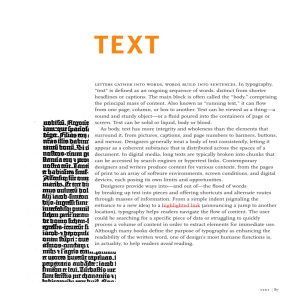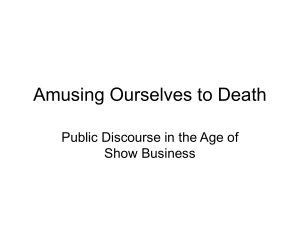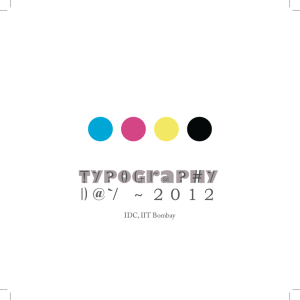AD106 - Billy Blue Communication Design
advertisement
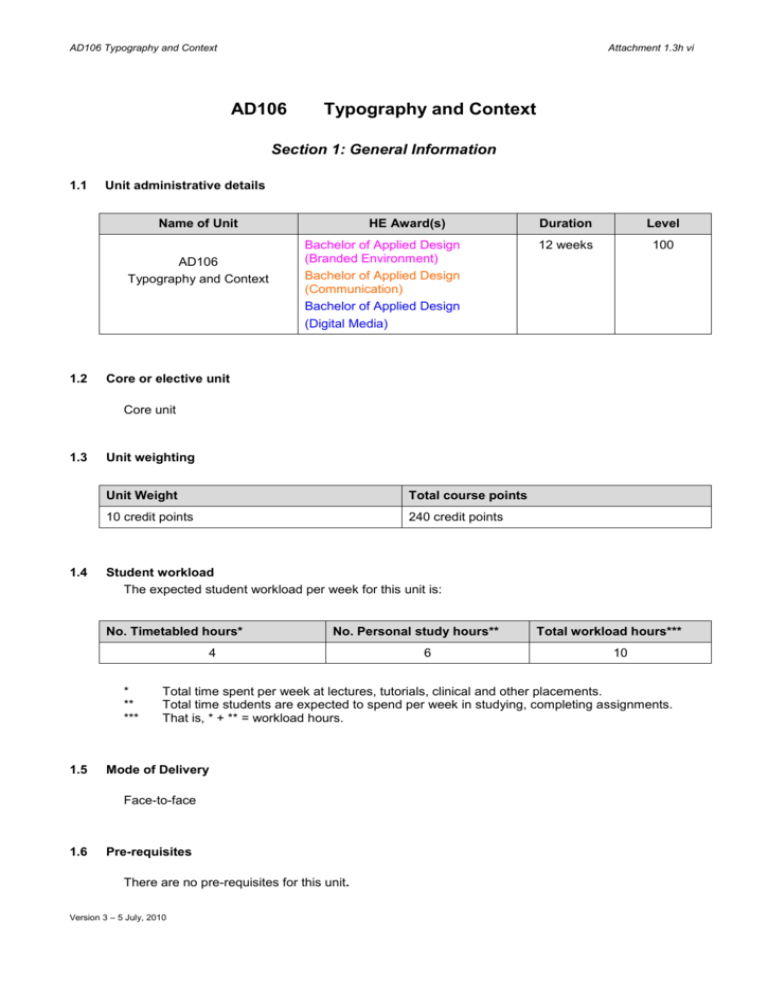
AD106 Typography and Context Attachment 1.3h vi AD106 Typography and Context Section 1: General Information 1.1 Unit administrative details Name of Unit AD106 Typography and Context 1.2 HE Award(s) Bachelor of Applied Design (Branded Environment) Bachelor of Applied Design (Communication) Bachelor of Applied Design (Digital Media) Duration Level 12 weeks 100 Core or elective unit Core unit 1.3 1.4 Unit weighting Unit Weight Total course points 10 credit points 240 credit points Student workload The expected student workload per week for this unit is: No. Timetabled hours* No. Personal study hours** 4 * ** *** 1.5 10 Total time spent per week at lectures, tutorials, clinical and other placements. Total time students are expected to spend per week in studying, completing assignments. That is, * + ** = workload hours. Mode of Delivery Face-to-face 1.6 6 Total workload hours*** Pre-requisites There are no pre-requisites for this unit. Version 3 – 5 July, 2010 AD106 Typography and Context Attachment 1.3h vi Section 2 – Academic Details 2.1 Student learning outcomes On successful completion of this unit students will be able to: 1. Demonstrate an understanding of principles and practices of typography 2. Illustrate effective responses to typefaces in contemporary branding 3. Explain the implications of information architecture (hierarchy) 4. Demonstrate the ability to experiment independently in the area of application 5. Display an awareness of social responses to typographic styling in the context of public practice 6. Give effective presentations based on self-directed experimentation. 2.2 Unit content and structure This is a core unit in the suite of Billy Blue Bachelor of Applied Design courses. The purpose of this unit is to study typography within a specific theoretical framework. This framework embraces the function of typography as a tool and means for communication. Students investigate how the understanding of typography influences the communication requirements of the designer and the theoretical foundations of typography that underpin its function and purpose. They develop their skills and experience in the use of typography as a means for communication as well as explore a range of concepts and issues such as emotional perception, cultural differences and social responses to typefaces in contemporary branding. The principles and practices of typography in print media, digital media, and branded environments are covered with the aim of advancing students’ understanding of typography as a design element through analysis of contemporary examples, self-directed experimentation and reflection of outcomes Indicative topics and when they will be discussed are outlined below. Unit Structure Week Topic Week 1: Review of evolution of typography Week 2: Examination of how type informs and is influence by perception and brand culture Week 3: Logo types: words and icons Week 4: Layouts and grid system: context and criteria Week 5: Production Week Week 6: Typographic selection for print, screen, and environment Week 7: Typographic experimentation Week 8: Typographic experimentation (Elements) Week 9: Typographic experimentation (Elements), continued Week 10: Production week Week 11: Type as narrative Week 12: Type as narrative, continued Week 13: Typographic experimentation – 3D letter forms Week 14: Typographic experimentation, continued – 3D letter forms Week 15: Review Week Version 3 – 5 July, 2010 Assessment Task Assessment Task 1 Assessment Task 2 Assessment Tasks 3 & 4 AD106 Typography and Context 2.3 Attachment 1.3h vi Teaching methods/strategies The unit will be delivered via four hours per week in a combination of face-to-face lectures, tutorials and studio practice. 2.4 Student Assessment Assessment Type When assessed Weighting Purpose Task 1 Typographic experiment (1) – self portrait using type as illustrative element Week 4 20% Each student will be required to integrate text, image and brand identity with printed collateral Task 2 Week 9 This assessment addresses student learning outcomes 1, 2 and 3 Brochure with grid and logotype Each student will be required to create an experimental illustration (self-portrait) that is restricted by typographical elements only. Task 3 Typographic experiment (2) – 3D letter forms in physical environment This assessment addresses student learning outcomes 1, 4 and 6 Each student will undertake a research activity that explores type as 3D object in physical environment. Students will be required to include a 250 word statement reflecting on their practice and their design outcome. Week 14 25% 25% This assessment addresses student learning outcomes 1, 3, 5 and 6 Task 4: Using type to communicate ideas and voice of narrative Version 3 – 5 July, 2010 Week 14 30% Each student will be required to create ‘voice of narrative’ by employing principles of layout, type hierarchy and type selection. This assessment addresses student learning outcomes 1, 3 and 5 2.5 Prescribed and recommended readings Prescribed: Lupton, E. (2007) Thinking with type, Princeton Architectural Press Perfect, C. (1992) The complete typographer, Prentice Hall Recommended texts Heller, S. and Meggs, P. (2001) Texts on Type: Critical Writings on Typography, Watson-Guptill Publications Heller, S. and Pettit, E. (2000) Graphic Design Time Line: A Century of Design Milestones, Allworth Press Hollis, R. (2002) Graphic Design: A Concise History, Thames & Hudson Honnef, K. et al. (2000) Art of the 20th Century, Taschen Hughes, R. (1992) Nothing if not critical: Selected Essays on Art and Artists, Penguin Nosich, G. and Nosich, G. (2000) Learning to Think Things Through: A Guide to Critical Thinking Across the Curriculum, Prentice Hall Stangos, N. (1994) Concepts of Modern Art: From Fauvism to Postmodernism, Thames & Hudson Swales, J.M. et al. (2004) Academic Writing for Graduate Students: Essential Tasks and Skills (2e) University of Michigan Press Websites: http://mitpress.mit.edu/e-books/HP/ www.1001freefonts.com www.2rebels.com www.acidfonts.com www.adgame-wonderland.de/type/bayeux.php www.allposters.com www.astigmatic.com www.bemboszoo.com www.bmasse.com www.dafont.com www.emigre.com www.fontcraft.com/scriptorium www.fontface.com www.fontfactory.com.au www.fontfreak.com www.fontpool.com www.goodbrush.com www.gutenbergdigital.de www.gyotaku.com www.houseindustries.com Version 3 – 5 July, 2010 www.identifont.com www.impressionistprints.com www.indianhillpress.com www.joecartoon.com www.lycettebros.com www.misprintedtype.com www.monib.com www.myfonts.com www.ni9e.com www.owlsoup.com/foamtrain www.psyops.com www.stencilrevolution.com www.t26.com www.typeculture.com www.typographi.ca www.typography.com www.typography.org.uk www.typophile.com www.typorganism.com www.veer.com Assessment briefs An assessment brief will be provided for each assessment. The brief will include information such as weighting, due date, learning outcomes, description of task, instructions, marking criteria, and submission instructions. Briefs will be provided to students well in advance of the due date of the assessment deadline. Meeting deadlines It is your responsibility to organise your time effectively in order to meet deadlines. If you are absent from class when a brief is delivered, it is your responsibility to obtain a copy of the brief from the lecturer, and the original deadline for the project will remain unless an extension has been approved. Extensions If you anticipate that you’ll need an extension for a project before the published deadline you must apply for the extension using an Application for Extension form. These forms are available from Student Services and the Learning Portal. The extension must be approved by the Program Director at least three days before the deadline. Extension can only be granted due to compassionate or compelling circumstances that are generally beyond your control and which have an impact upon your course progress or wellbeing. Submission of assessments Assessments are to be submitted directly to the lecturer by the due date. Hardcopy submissions are to be handed directly to the lecturer, and softcopy documents submitted in the lecturer’s drop box. Your lecturer will maintain a record of the submission to avoid any later confusion. Three-dimensional submissions (such as sculptures and models) are to be accompanied by a photograph. You can take your 3D work home on the day of assessment after the lecturer has assessed it, leaving the photograph as a reference for your lecturer. Late submissions Late assessments are to be submitted at the Resource Centre, and need to be accompanied by a Late Submission form, which is available from the Resource Centre and Learning Portal. The form is to be completed by the student, and signed off by Resource Centre staff. If you hand work in late due to illness or compassionate or compelling circumstances, attach documentary evidence to the Late Submission form. In such cases, the work must be submitted on your first day back at College. Late work attracts a penalty of 10% per day, unless the lateness is due to compassionate or compelling circumstances. Reassessments If you obtain a mark of 45%-49% for an assessment, you can request a reassessment from your lecturer within 5 working days of receiving the result. Only one reassessment can be offered for each failed assessment. A successful reassessment can only be awarded a Pass. Version 3 – 5 July, 2010 Academic Integrity Any form of plagiarism or other type of academic misconduct may endanger your position at the College. Behaving with academic integrity means valuing honesty in learning and submitting assignments and exams that are all your own work (except for reference material acknowledged appropriately), and you never help others to cheat on assignments and exams. Plagiarism refers to the deliberate or inadvertent use of someone else’s intellectual property without proper acknowledgement. Any borrowing, and its source, must be clearly indicated in your text, not just a reference list at the end. If you incorporate material from secondary sources to support your research or arguments, then the reference to these sources should be clear and unambiguous. Academic misconduct includes: Plagiarism, and failing to properly acknowledge sources Taking unauthorised material into exams Permitting others to copy answers in an examination or assessment Exchanging notes in an exam Inappropriately obtaining prior knowledge of an exam’s contents Downloading material from the internet into an assessment or using material purchased, acquired, or commissioned from sources that write assignments for payment. Incorporating material that has been previously submitted for assessment, without so stating. If inclusion of previous work is warranted it should be referenced fully Presenting group work as an individual assignment. Penalties for plagiarism or other types of academic misconduct range from a verbal or written warning; surrendering unauthorised materials; downgraded marks; failure, or being deemed Not Yet Competent for item(s) of assessment; failure of a unit of study; to suspension or expulsion. Familiarise yourself with information on how to avoid plagiarism and what is good practice. (Refer to the Think: Colleges Academic Writing Guide). Attendance You are required to attend all your classes and any additional events organised by your lecturers. You are also required to arrive on time. If you arrive more than15 minutes late, you will be marked as absent, regardless of reason. Students should refer to the current student handbook for more detailed information about their participation in Billy Blue courses. Version 3 – 5 July, 2010
